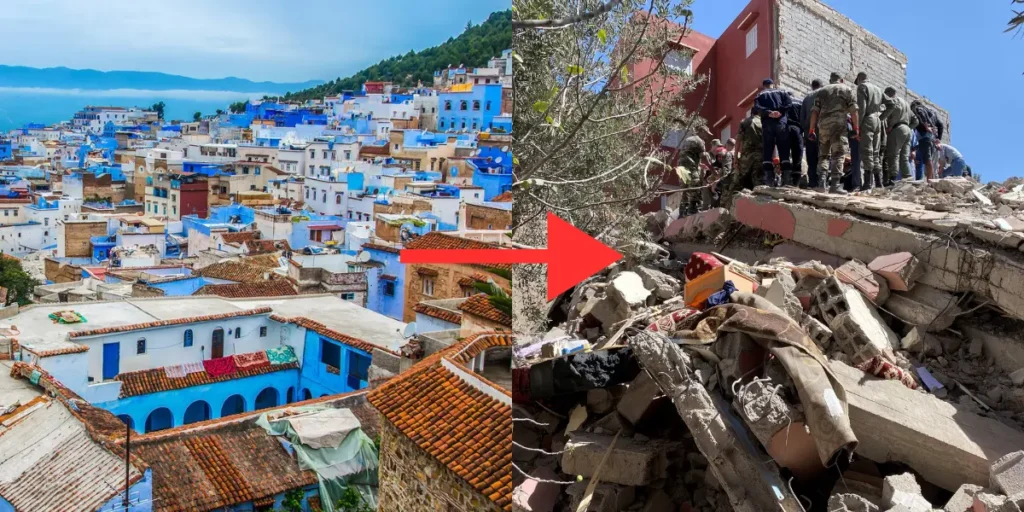Morocco Earthquake Update: On Saturday morning, the Interior Ministry of Morocco officially confirmed a devastating toll from the recent earthquake, with at least 1,037 reported fatalities and over 1,200 individuals sustaining injuries.

Table of Contents
A very strong earthquake with a magnitude of 6.8 hit Morocco on Friday night. This caused a lot of damage, and sadly, more than 1,000 people have lost their lives. State television, as reported by Reuters, shared this information.
Rescue teams are working really hard to find people who might still be alive under the collapsed buildings and debris. The number of people affected by this earthquake might go up as they keep searching for survivors. It’s a very difficult and sad situation.
On Saturday morning, Morocco’s Interior Ministry officially confirmed that at least 1,037 people have lost their lives due to the earthquake. Most of these casualties occurred in the popular tourist city of Marrakech and in five nearby provinces, close to where the earthquake originated. Additionally, a significant number of 1,204 individuals have been injured as a result of the earthquake. It’s truly a tragic situation, with many people affected by this devastating event.
Pictures and videos have been shared from various places across the country, and they reveal how frightened people were when the earthquake hit. People were abruptly awakened by the powerful tremors and were seen rushing out into the streets, filled with fear and disbelief. This earthquake is said to be the strongest one to hit Morocco in 120 years, which makes it a very rare and severe event for the North African country.
One significant issue is that Morocco’s infrastructure has been seriously harmed. Many of its historic cities have buildings made of stone and masonry, which are more vulnerable to earthquakes. These old structures couldn’t withstand the force of the quake, leading to extensive damage. It’s a reminder of how important it is for buildings to be constructed to withstand such natural disasters to protect people and property.
Top updates on the Morocco earthquake:
- Even though Algeria had cut off its diplomatic relations with Morocco last year, they announced on Saturday that they would allow humanitarian and medical flights to operate between the two countries to assist Morocco after the earthquake. This gesture is a sign of solidarity during this difficult time.
- Algeria also expressed its heartfelt condolences to the Moroccan people for the loss of lives due to the earthquake, as shared by the Ministry of Foreign Affairs. It’s a reminder that in times of crisis, nations can set aside their differences to help each other.
- Out of all the people who were injured in the earthquake, a concerning 721 individuals are in critical condition, as stated by the interior ministry. It’s a critical situation for them, and they need urgent medical attention.
- The ministry also pointed out that a majority of the casualties, which means the people who lost their lives or got injured, occurred in two places: Al-Haouz, which was the epicenter of the earthquake, and the Taroudant provinces. These areas were the most affected by the quake, and it’s where the damage and impact were the greatest.
- After the earthquake, Morocco’s King Mohammed VI took swift action. He ordered the country’s armed forces to get ready with aircraft, ground vehicles, specialized search and rescue teams, and even a surgical field hospital. This shows the government’s commitment to helping the affected people and managing the crisis effectively, as mentioned in a military statement.
- Although many countries around the world have expressed their condolences and offered to help Morocco, it’s important to note that the Moroccan government hasn’t officially requested assistance yet. This formal request is necessary before outside rescue teams can come and provide their support. It’s a standard procedure to ensure that aid is coordinated effectively and that all necessary resources are deployed to where they are most needed.
- Not only world leaders but also Pope Francis extended his support and solidarity to the people of Morocco. In a message sent to Morocco by the Vatican’s Secretary of State Pietro Parolin, it was conveyed that “The pope expresses his profound solidarity with those who are affected both physically and emotionally by this tragedy.” The Pope’s message is a gesture of compassion and empathy, showing that people around the world care about the well-being of the Moroccan people during this difficult time.
- Local media outlets have reported that rescue efforts are encountering difficulties because the roads leading to the mountainous area near the epicenter of the earthquake are congested. These roads are blocked by vehicles and debris, making it challenging for rescue teams to reach affected areas quickly.
- After the initial earthquake, there were also smaller aftershocks recorded at the epicenter, which is in the Al Haouz region. Nasser Jabour, the director of Morocco’s National Institute of Geophysics, shared this information on the national broadcaster SNRT. He urged citizens to remain calm during this tense time. Aftershocks can be unsettling, but it’s important for people to follow safety guidelines and stay composed to ensure their well-being.
- As of Saturday morning, we still don’t have a complete picture of the damage caused to Marrakech, a UNESCO World Heritage site that is beloved by tourists. While many of the major historic sites in the old part of the city seem to have escaped significant damage, there have been unverified videos circulating online. These videos show cracks and fallen debris in a small portion of the medieval walls and a collapsed minaret. It’s essential to wait for official assessments to get a clearer understanding of the overall condition of Marrakech’s historic treasures.